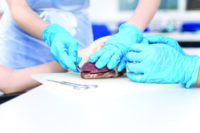The chemistry behind environmental dyes
In the springtime, it’s common to see articles about how to dye eggs with natural dyes, but eggs aren’t the only things that can be dyed. Since ancient times, humans have used materials from their environments to color their world.
Chemistry of cloth dyeing
The cuticle of eggs, which is where color binds to the shell, is made up of proteins. Many of the same dyes that can be used on eggs can also be used on other proteins, like those found in wool and silk. Unlike eggs, cloth needs to hold its color for more than a few days. While there are many things that can stain cloth–think grass or berries–only a few of them are sufficiently colorfast to be used for clothing. One way to improve the bonding of dye to cloth, and thus improve colorfastness, is to use a mordant. A mordant is a chemical, usually a metal salt, that has an affinity for both the protein in the fiber and the color agent in the dye. The mordant used can change the final color of the cloth. Because dyes adhere to protein fibers via hydrogen bonding between polypeptides and the dye, pH can affect the final color as well. Various weak acids, such as vinegar, or weak bases, such as baking soda, may be used in the dye bath as fixatives and color adjusters.
The fiber
Silk is produced by several species of silkworms as the caterpillars spin cocoons in preparation for becoming moths.

Bombyx mori, the silkworm responsible for most commercially made silk,has been under cultivation for almost 5,000 years–its domestication predates that of chickens and cats.

The silk itself is made up of 2 main proteins, sericin and fibroin. Fibroin forms the central filament of the silk while sericin binds the fibroin filaments together to form the cocoon. Most of the sericin is removed during the processing of the silk into yarn or thread. Fibroin is made up of beta pleated sheets of the amino acid sequence Gly-Ser-Gly-Ala-Gly-Ala.

The pigment
Onion skins make an excellent source of a natural dye. The tannic acid present in onion skins acts as an organic mordant, so a metal salt is not necessary; using one will change the color of the final product. While the colors produced are slightly different, depending on the variety of onion used and other compounds found in the skins, the primary dye component is called pelargonidin (3, 5, 7, 4 tetrahydroxy antocyanidol).

Preparing and dyeing silk fabric
To dye silk fabric with onion skins, you must first prepare the silk by soaking it in a mordanting solution (optional) or water. Alum (potassium aluminum sulfate) is a popular mordant because it is readily available in grocery stores. The mordant should be about a quarter of the mass of the fiber to be dyed.
Ferrous sulphate and copper sulfate can also be used as mordants, but they are toxic. Care should be taken when working with them. Alternatively, using an old iron or copper pot to boil your fiber can shift the colors slightly. Even when using nontoxic chemicals, it is recommended that you use a dedicated dye pot that is not used for food.
Preparing the dye:
- Remove the onion skins from the onion. Only the dry, papery skin is used.
- Place the skins in a pot, and add enough water to just cover them.
- Bring the water to a boil. Boil for 1 hour, adding more water as necessary to keep the skins covered.
- Carefully strain out the skins, retaining the liquid.
Dyeing:
- Add the silk to the dye pot. Make sure that the fabric has enough room to move freely in the dye bath, or the pigment may collect in the folds (see the image below).
- Bring the dye pot to a low simmer. Remove the fabric from the dye bath when it has reached the desired color (20 minutes to 1 hour).
Temperature also affects the rate of binding of various minor dye agents to the fabric and can change the shade of the final fabric. Fabric can be dyed cold, over a much longer period of time, and yield slightly different results.
Below are several images demonstrating the effect that pH can have on both red onion dye and yellow onion dye. In this case, the acid treatment was soaked after mordanting in vinegar, and the basic treatment was soaked in a solution of sodium bicarbonate (baking soda).






